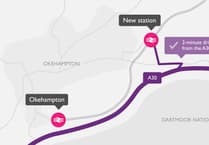FOLLOWING an article by railway journalist Steve Broadbent in an earlier edition of the Times on proposals to resinstate the Bere Alston to Tavistock line another rail enthusiast, John Snell, describes the layout of the old track.
Mr Snell, from Bere Alston, worked for British Rail for 46 years. After starting work in the booking office at Calstock Station in 1949, he ended his career as internal control officer for Devon and Cornwall.
He is a member of Bere Alston and Calstock local history groups. He writes:
Both Tavistock and Bere Alston stations were opened on June 2 1890 by the Plymouth, Devonport and South Western Junction Railway company, while the line itself from Lydford to Plymouth was leased to the London and South Western Railway. It gave the London and South Western Railway a through route from Waterloo to Plymouth with double track. Tavistock was 213 miles and 59 chains from Waterloo while Bere Alston was 220 miles and 15 chains from Waterloo.
Building the line started in March, 1887 some 2,000 navvies were employed and by a stroke of good fortune Tavistock Hospital was opened on July 19, 1887 so accidents could be treated there.
The rail service continued until the last passenger trains used Tavistock North on Sunday, May 5, 1968.
The route — Tavistock station was built just before the stone Bannawell Street viaduct number 656 (all SR bridges were numbered from Waterloo) and the line started to climb at 1 in 75 through a deep cutting which was spanned by three stone arch bridges, Glanville Road bridge (no 657), Old Launceston Road bridge (no 658) and Watts Road bridge (no 659). During the construction of this part of the railway a rich seam of copper was found.
At mile post 214 was the summit of the climb. The line descended at 1 in 75 before starting a longer stretch of 1 in 313. It ran under the Launceston Road bridge (no 660) — Tavistock to Launceston Road and the line emerged from the cutting to cross an embankment. It then ran under Crease Lane bridge (no 661) and continued into Abbotsfield. The line crossed the main Tavistock to Gunnislake line at Abbotsfield Road bridge (no 662).
After leaving Abbotsfield the line curved gently to the left to run in a southerly direction, first on an embankment incorporating arch under bridge Crowndale Cattle Creep (no 663) which took a minor road across the railway, then in a cutting and then on to another embankment in which Crowndale Bridge (no 664) took a minor road across the railway. The line then came to Shillamill viaduct (no 665).
This magnificent structure with 12 spans each of 50ft took the railway over the River Lumburn and the Tavistock canal. Shillamill Viaduct was designed to have two extra arches but these were replaced by an embankment at the tunnel end. The reason for this was the Wallabrook viaduct north of Tavistock, which was not planned as a viaduct but as an embankment. This was found impractical which meant the builders had thousands of cubic yards of soil to get rid of so this was used at Shillamill — shortening Shillamill viaduct by two spans in the process.
The line then took a 1 in 75 descent and crossed Backford Lane bridge (no 666) a stone arch structure and continued into Shillamill woods. At milepost 216 was another stone arch under bridge (no 667) followed by Lazy Bench Hill bridge (no 668). The railway then quickly entered Shillamill tunnel (no 669). The tunnel was 603 yards long and on a gradient of 1 in 98; it was in a shape of an 'S bend' with 24 chain curves at each end. Bricks used to line the tunnel came from Bealswood brickworks at Gunnislake.
Coming out of the tunnel at Broadhall the line curved through almost 90 degrees to the left, climbing at 1 in 98 to a hilly area where the River Tavy could be seen below.
At milepost 217 the line crossed a track by means of Broadwell bridge (no 670) before going under Broadwell Farm bridge (no 671) and then turning right onto another long curve. The gradient now eased to 1 in 120 through a long cutting and then it came to Ravens Rock bridge (no 672) the line ran for a short length of 1 in 594 to a summit on the line. From here it descended at 1 in 75 on an embankment. Passing milepost 218 it straightened to the south west and passed under Hocklake bridge (no 673) a stone arch across a lane. The gradient steeped to 1 in 75 for a mile over another lane at Higher Gawton bridge (no 674) and then went under Gawton bridge (no 675) where the road crossed to Tavistock — these were both stone arches.
The line then ran to the south west on a low embankment from where an excellent view of Calstock Viaduct could be seen. Two more narrow lanes were crossed by means of Lower Gawton bridge (no 676) — Milepost 219 was near here — and Rumleigh bridge (no 677). Then came Harewood bridge (no 678), Tuckermarsh bridge (no 679) and Rumleigh Road bridge (no 680).
The railway then bottomed out on a level and climb at 1 in 75 where there were more views of the Tamar Valley where often the market garden greenhouses glinted in the sun.
Running west up a 1 in 165 gradient the line passed over two lanes on stone arch bridges (nos 681 and 682) at Bunkers Hill. The gradient now eased to 1 in 330 around a gentle left-hand curve past milepost 220 into Bere Alston station.
Gradients — The British style practice measure is horizontal distance required to raise the level of the line by one unit. Thus a line, which rises or falls by 2ft over 500ft is said to be 1 in 250. Line-side gradient post shows incline in each direction.
Famous trains that passed over the line were The Brighton, The Atlantic Coast Express and the all Pullman Devon Belle while famous engines using the line were Bulleid West Country Pacific's, Drummond T 9s and Drummond M7 Tanks and Maunsell N Class.


